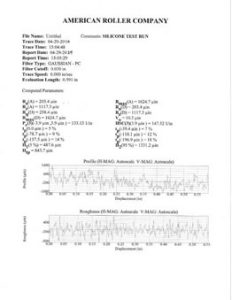Surface Roughness of Rollers
Surface roughness plays an important role in determining surface COF (Coefficient of Friction), wear and release properties. The coefficient of friction often symbolized by the Greek letter µ, is a dimensionless scalar value which describes the ratio of the force of friction between two bodies and the force pressing them together. The COF depends on the materials used; for example, ice on steel has a low coefficient of friction, while rubber on pavement has a high coefficient of friction. Coefficients of friction range from near zero to greater than one.
Roughness or texture of a roller surface can be acquired by measuring the roller profile using a profilometer. There are two types available, 3D Optical (white light interferometer) or 2D Contact (diamond stylus, each having various models and can be stationary or portable (2D Contact only). Portable contact profilometers make it easier to use in production environments due to its compact size.
There are many different roughness parameters in use, but Ra, the arithmetic average of absolute values of peaks & valleys of the sample length measured, is the most common referred to in the roller manufacturing industry. Another common parameter is Rz, the average between the 5 highest peaks & lowest valleys in the sample length being measured. A roller surface with a large Ra or Rz value will usually have a higher COF, which may wear faster and have poorer release properties. Controlling the roller surface finish is an important factor in roller performance. There are various Ra’s that can be achieved for each type of roller covering. Contact your roller company with your specific application.
Measuring Surface Roughness of a Roller
2D Contact Profilometer is the most common type used in measuring roller roughness. It is important to ensure the roller surface is cleaned prior to testing. The profilometer’s diamond stylus (Figure 1) is moved vertically until contact is made with the roller surface at a specified contact force and then moved laterally across the surface for a specified length.

The profilometer measures small surface variations asa function of the stylus’s changing position during the test. A typical profilometer can measure peaksranging in height from 10 nanometers to 1 millimeter. The height position of the diamond stylus during the test generates an analog signal which is converted into a digital signal stored, analyzed and displayed. Values can be displayed as either micro meter or micro inch.
A common roller Ra specification for American Roller rubber compounds falls between 35-65 Ra micro inches. A surface roughness measurement cannot depict any patterns on the roller surface.
We can easily provide the surface profile data you require for your application needs (Figure 2).

American Roller and Plasma Coatings use contact profilometers for their development, manufacturing, and quality control processes.
Advantages of 2D Contact Profilometers
- Acceptance: Most of the world’s surface finish standards are written for contact profilometers
- Surface Independence: Contacting the surface is often an advantage when the roller is used in dirty environments. Noncontact methods can end up measuring surface contaminants instead of the surface itself. Because the stylus is in contact with the surface, the contact method is not sensitive to surface reflectance or color
- Resolution: The stylus tip radius can be as small as 20 nanometers, significantly better than white light optical profiling. Vertical resolution is typically sub-nanometer as well
- Direct Technique: No modeling required
- Portable Instruments available
Disadvantage of 2D Contact Profilometers
- Not well suited for very soft materials, as the stylus tends to drag or stick
Advantages of 3D Optical Profilometers
- Best for small parts and requirements to do 3D scanning. The noncontact profilometer does not touch the surface. The scan speeds are dictated by the light reflected from the surface and the speed of the acquisition electronics (Figure 3)
- Reliability: Optical profilometers do not touch the surface and therefore sample cannot be damaged by surface wear or careless operators. Many noncontact profilometers are solidstate which tends to reduce the required maintenance significantly
- Resolution: Lateral resolution ranges from a few micrometers down to sub micrometers. Ideal for very high durometer, high polished surfaces

Disadvantages of 3D Optical Profilometers
- When measuring large parts, a 3D scan on an optical profiler can be much slower than a 2D scan on a stylus profiler
- Portable Instruments not available
- Expensive
January 2, 2015
J Buetow
To view a pdf version, click here.
